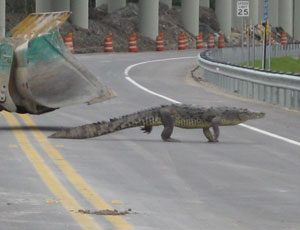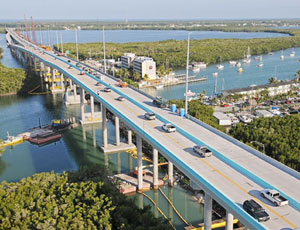When Florida pioneer and rail baron Henry Flagler pushed his Florida East Coast Railway south to Key West in the early 1900s, his engineers and laborers gave little thought to the environmental impact of their dredging and filling. That wasn’t the approach taken by the engineers and contractors now punch-listing a seven-mile-long reconstruction of a stretch of what became the Overseas Highway. They went out of their way to protect many species of aquatic life, taking care, among other things, not to rock the world of the crocodiles that inhabit the waters.

Granite Construction of Tampa, a unit of the Watsonville, Calif.-based contractor, has taken pains not to disturb endangered species and to restore natural water flow. “This job borders the Everglades National Park and environmental issues are a major concern,” says Michael Derksen, project manager with Granite. “We’ve had to take a proactive approach.”
For nearly 20 years, the Florida Dept. of Transportation had planned to improve the two-lane highway, which has a long history of fatal accidents and is the only route on or off the hurricane-prone Florida Keys. Throughout that time, as various plans for four-, three- and two-lane enhancements came and went, Granite and others in the industry kept an eye on its progress, says Tom Boyle, project executive for Granite.
Granite teamed with Jacobs Civil of Miami in 2003 in anticipation of the project being advertised by FDOT as a design-build job. In 2004, with permits in hand for a two-lane replacement bridge over Jewfish Creek, linking the Keys to the mainland, the department sought bidders for the project.
Boyle says he saw it as a good fit for the company, with its mix of bridge and roadwork. Granite received the $147.8 million contract in 2004, with a Jan., 2005 start. The company has self-performed all of the civil work.
Overview
The project included construction of a 1.5-mi-long bridge, replacing the 1944-era, bascule bridge at Jewfish Creek and a causeway crossing Lake Surprise. It also included widening of the existing road, for five miles north of the bridge and two miles south of it. The reconstructed section includes two, 12-ft travel lanes, separated by a concrete median; a 10-ft northbound shoulder that can convert to a travel lane during hurricane evacuations; and an 8-ft southbound shoulder.
“This is a significant project for the local residents that will allow more efficient and effective [hurricane] evacuations,” Derksen says.
This engineers designed the project as a component of the Comprehensive Everglades Restoration Program (CERP), an effort to help restore original flows in the Everglades and throughout the Keys. Mindful of the environmental sensitivities, Granite educated its workforce about the importance of dealing with manatees, sea turtles, dolphins, osprey, crocodiles and snakes in “an appropriate manner.” Staff was warned not to do anything that could be considered harassment. In addition, the contractor took care to remain within clearing limits and not to disturb indigenous and endangered mangroves. Finally, excess material from the project was used to restore several acres of sensitive habitat at neighboring Florida Department of Environmental Protection and Crocodile Lake National Wildlife Refuge properties.
The Road North
Granite teamed early with Hayward Baker, a geotechnical contractor based in Odenton, Md., to provide a solution to managing the mucky, organic soils needed to widen the roadbed north of the Jewfish Bridge.
Hayward Baker devised and carried out a strengthening, soil-mixing process that allowed for road building on top of the existing muck, rather than surcharging or hauling out the unsuitable soil. Crews used a rototiller-like device on a backhoe boom to pump in a mixture of 25% cement and 75% slag and mix it up with the existing soil to a depth of 10 ft, when they hit rock. When the mixture hardened, it was strong enough to support the road.
“The operator drags the rototiller underground in the soft material, back and forth and up and down, until he puts in the prescribed amount of cement and slag,” Larson says.
Larson says he is not aware of any other jobs in the United States that have used the methodology. A Hayward Baker sister company had performed similar work in Europe.
“That was a key factor of us being successful on the job,” Boyle says. “FDOT District 6 liked the idea and was willing to give it a try.
Granite crews placed 6 ft of fill on top of the mixture and built the road. The Cemex Card Sound Mine in Florida City, Fla., supplied the lime rock for the roadbed and the ready mix for the bridge. Granite milled the old asphalt and blended it with new to reconstruct the existing lanes.
Along this section of U.S. 1, north of the bridge, Granite built nine box culverts to allow crocodiles to pass under the road. That work is now complete.
The contract completion date is Aug. 5, 2009, with a milestone date and a $2.4 million bonus tied to a June 12, 2009, finish. Granite expects to earn it and plans to wrap up construction during the first quarter of 2009.
Jewfish Creek Bridge
A key part of the project was replacing the low drawbridge, which had to be locked down during storms, with a high-level bridge with a 65-ft clearance. It now spans Jewfish Creek and then continues as a low-level bridge over Lake Surprise. Sailboats and other watercraft will be able to pass under the structure even during hurricane warnings.
“A 7,500-ft bridge replaces a 300-ft-long drawbridge because we are replacing existing road fill,” says John Larson, senior project manager with Jacobs Civil.
Granite has excavated and removed from the water the former causeway built by Flagler’s team. Sea grass is expected to fill in, and crocodiles and manatees will be able to move about in the saltwater lake.
“There is no channel between the two sides [of the lake], and it’s a habitat for the American crocodile,” Larson says. “It opens the water body up to improve the quality of the water in the lake and enhance the habitat for an endangered species.”
The bridge foundation features about 260 48-in. and 60-in. drilled shafts and 69 piers. The work took place from floating platforms.
Mindful of the environmental impact of the construction project, crews had minimal access to build the new structure. It was extremely tight for cranes, which worked off a trestle bridge built perpendicular to the roadway. The cranes set more than 450 beams at night to lessen disruption to traffic.
Standard Concrete Products of Tampa cast the 92, 78-in Florida modified bulb-T beams, the 343, 72-in Florida modified Bulb-T beams and the 29 AASHTO type IV prestressed beams. Trucks brought some to the project, but others, including the 160-ft-long center span, were shipped by barges from Tampa to Key Largo.
Granite completed the bridge and opened the northbound lane to two-way traffic in May, before the hurricane season began.
Four ramps in a tight diamond pattern will provide access to businesses around Jewfish Creek. Beams for the ramps are set using a long hydraulic crane sitting on the completed bridge. The ramps from the southbound lane lead to a rotary intersection.
“We didn’t have enough room once we were off the bridge ramps to make a right turn without going over the right of way, so we come down to a roundabout,” Larson says.
Boyle started demolition of the old bascule bridge and removed its two foundations from the creek to allow water to flow more naturally again, and it will restore the shoreline.
This article first appeared in Southeast Construction http://southeast.construction.com/features/archive/0809_Feature1.asp.






















Post a comment to this article
Report Abusive Comment